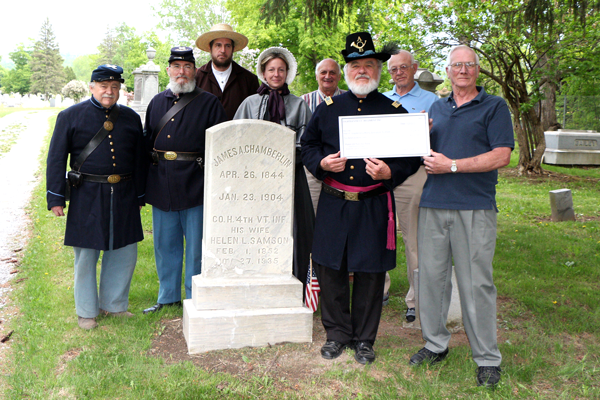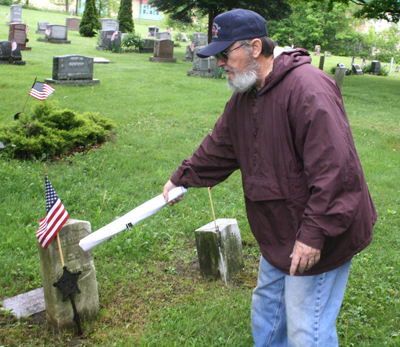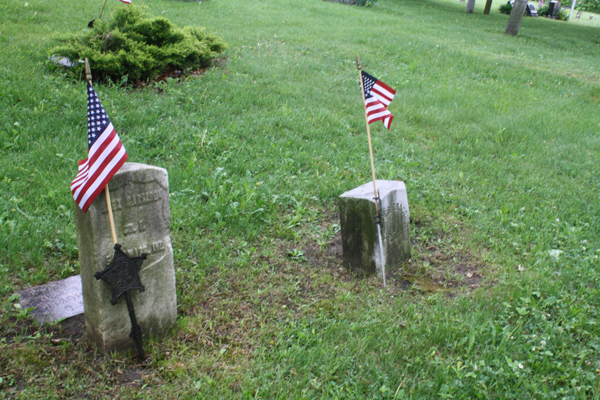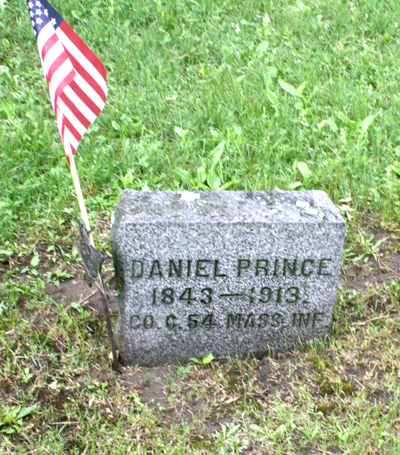Within a week of Memorial Day, 2013, Jim Fouts of the 18th Vermont Regiment, a statewide historic preservation group, walked the rows of the Greenwood Cemetery on a drizzly Tuesday, May 21, morning.

President of the 18th Vermont Regiment Bill McKone (in uniform) presents a check for the restoration/repair of Civil War veterans’ headstones in Greenwood Cemetery to Dale Coon, member of the Greenwood Cemetery Association. The group stands at the grave of James A. Chamberlain, who served in the 4th Vermont Infantry and died in 1904. The Civil War veteran’s wife, Helen Samson Chamberlain, who was 12 years his junio, also lies here, having died in 1935. From left to right are: Charlie Martin, Jim Fouts, Bob Bushnell, Lynn Sawyer, Mark Maloney, Bill McKone, Bill Crocker and Dale Coon.
He searched for those who served their country during the Civil War, laid to rest long before any current Franklin County resident was even born.
Gravestones honoring veterans here are decorated with small American flags. Many of the memorials have been damaged over the years, including more than 50, which were ravaged last year by vandals.
Dale Coon, a cemetery groundskeeper, said that about a week’s worth of labor and an estimated $1,500 to $1,800 in material costs went this year to fix the damaged stones.
The identity of the vandals remains unknown.
Tractors were brought into the quiet cemetery to right and level the memorial markers. Crushed stone and topsoil was laid down for new lawn.
Fouts, of St. Albans and Gettysburg, Pa., first saw a Messenger report about the vandalism and decided to help out. The members of 18th Vermont pooled money to accomplish the task. On Tuesday they presented a $200 check for the cemetery’s use.
The group also raises money for Civil War battlefield preservation.
Local History

Jim Fouts points to the modest grave of Alex Garrison, the last marking of a local man who fought in the Civil War a century and a half ago.
Fouts is compiling information for a book about Civil War soldiers from this area. He has a large, database of names, birth and death dates, burial information, when and where it is available, and other facts about more than 400 soldiers.
He has spent days wandering around the cemetery in the last few years, looking for notable names and markers. Record keeping during the Civil War days was “a little wooly,” he said, and names found in records at that time often were spelled phonetically, which causes confusion today
Fouts lives in Gettysburg, now, but comes back to St. Albans for the summer. On Tuesday he visited a number of interesting Greenwood graves.
Peter Brace, Alex Garrison, and Daniel Prince, who survived the war, are remembered with small, simple grave markers, lined up in the same row. Flags note service to their country. The men were in the 54th Regiment Massachusetts Volunteer Infantry, one of the first African American units.
Their graves are towards the back of the cemetery, others from their unit along the side, near the proverbial back of the bus, Fouts explained. Racism ran rampant in both the North and South, and it was unusual for troops of color to be buried among white people, he added.

Jim Fouts points to the modest grave of Alex Garrison, the last marking of a local man who fought in the Civil War a century and a half ago.
St. Albans and Greenwood Cemetery historian Carl Johnson, author of a book about the St. Albans Raid, has said that the 54th regiment was widely held to be the first black fighting unit in the Civil War. The heroics of that regiment were detailed in the 1989 Hollywood movie, “Glory,” starring Denzel Washington and Morgan Freeman.
Fetus’s list shows five area men having served in the 54th, most having the last name Prince.
Many of men who served from this area have names still remembered in the community. Coon said the cemetery is now more than 200 years old, having been established in 1802 or 1804, and explained that many street names in St. Albans come from families having grave plots within the cemetery’s 13 acres.
“There’s a lot of history in there for sure,” he said of Greenwood.
Joseph Brainerd, whose family lives on via street signs, was wounded and taken prisoner during the war, eventually dying of scurvy in the notorious Confederate prison, Andersonville, Ga. on Sept. 12, 1864.
His body is not buried in St. Albans, but his marble memorial notes that he was “wholly neglected by President Lincoln.”
When Lincoln was assassinated, Fouts explained, a group of local people went to the stone, tied rope around it, and tried to remove it. They mostly failed, although the stone did land on its side, and had to be righted later.
Life During War
Fouts explained that during the Civil War St. Albans was a well-to-do community. It was a marketplace with shops that were sophisticated for the period, a county shire with a courthouse, a railroad center that shipped freight and facilitated easy transportation. It also was a manufacturing center employing hundreds of foundry and railroad workers.
“It was a prosperous New England town,” Fouts said, evidenced by having multiple banks – three of which were robbed by Confederates during the St. Albans Raid of Oct, 19, 2014, which was the northernmost land-based military action of the Civil War.
The cemetery’s large cemetery monuments from the period show the wealth held by locals – many are of marble with intricate with grandiose engravings.
Fouts said it was a Vermont hub of both commerce and culture.
There were also free black people here, but Fouts is not certain of just how many lived here then
Though the war dealt with slavery and the emancipation of oppressed peoples, Fouts said Vermont soldiers more likely fought out of patriotic fervor and the desire to join friends and family members who had signed up for battle.
He recalled the groundswell of American pride after 9/11 and said the same probably grew out of the battle at Fort Sumter in Charleston, S.C., which started the Civil War. It should be remembered, he said, that while the nation’s founding fathers seem ancient figures to Americans today, they were really only a few generations removed from the Civil War soldiers.
The country was still new and its men wanted to fight to preserve the union and on behalf of those enslaved in the South, Fouts said.
Unfortunately, that period of war was difficult on families. With fathers and sons alike gone to war, those left at home had to compensate. Fouts has read heart-wrenching letters from women, begging their husbands to return to them.
Upon returning home, soldiers no doubt faced some of the same problems — physical, emotional, and financial — plaguing veterans today.
Fouts noted that in the years following the war era, the Wild West came into being. A large number of Vermonters headed towards the Pacific during that time, many were probably better equipped to move having served during the war outside of their small home state. The promise of flat land and rich soils elsewhere were also a draw.
Some, however, had simply struck by wanderlust. Going from the heat of battle back to the hayfields was just too big of an adjustment to make.
Substance abuse was likely common, too. Some illicit substances were not yet illegal, and though he can’t say for certain, Fouts’s educated guess is that alcoholism was a cultural problem.
The Grand Army of the Republic, similar to the Veterans of Foreign Wars and other similar organizations today, was popular, offering men a chance to socialize with those who understood what they had seen and gone through in wartime.
Fouts said he could only hypothesize, but those returning home must have had dreams and nightmares after the horrendous sights of war.
Cemetery markers stand testament to the fact that many men died soon after returning home.
Preservation

Daniel Prince is remembered with a simple grave marker. The African-American served in the Civil War, 54th Regiment Massachusetts Volunteer Infantry, one of the first official African-American units.
Fouts and Coon believe cemeteries are places to show respect. Those who leave trash, including soda and beer cans, strewn among Greenwood’s graves, trouble coon.
“The cemetery belongs to everybody,” Coon said, it is a part of the community at large, and therefore the community’s responsibility.
Fouts said the Civil War era, now far from today’s collective memory, is often forgotten on days other than those celebrating veterans.
Gravestones, he said, are tangible evidence that there was a person alive at one time, who in some way contributed to society. That is what makes destruction and vandalism of the monuments so terrible, he added. The memorials are the last visual likeness of a real person.
“All these people were loved by someone,” he said.
Fouts added that death is treated differently today than during the Civil War era, when families themselves cared for dead bodies, had caskets made by the local carpenter, and laid their loved ones to rest.
“I think we’ve sanitized death,” he said.
— — —
Those wishing to donate to the Greenwood Cemetery can do so by making checks payable to St. Albans Cemetery Association, Inc. and mailing them to Greenwood, P.O. Box 920, St. Albans, VT, 05478. This article is posted with the permission of the St. Albans Messenger



